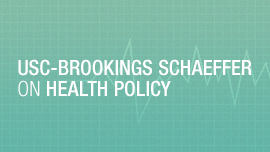This blog post is part of the USC-Brookings Schaeffer Initiative for Health Policy, which is a partnership between Economic Studies at Brookings and the University of Southern California Schaeffer Center for Health Policy & Economics. The Initiative aims to inform the national health care debate with rigorous, evidence-based analysis leading to practical recommendations using the collaborative strengths of USC and Brookings.
New legislation (H.R. 485) that is currently being debated in the House Energy and Commerce Committee and a letter to the Department of Health and Human Services (HHS) from Republican members of the Senate Finance Committee present a threat to Medicare’s new and already limited ability to negotiate over some high-priced prescription drugs. The language in these documents could prevent the HHS secretary from utilizing invaluable comparative metrics in seeking to deliver better value for Medicare beneficiaries.
The Inflation Reduction Act (IRA, PL 117-169) requires the secretary of Health and Human Services to negotiate the prices of single-source, high-priced drugs that are also high volume, starting with 10 drugs in 2026 and rising to 20 in 2029 and beyond. The legislation also requires the secretary to gather and consider evidence about the “comparative effectiveness of such drug and therapeutic alternatives to such drug, taking into consideration the effects of such drug and therapeutic alternatives to such drug on specific populations, such as individuals with disabilities, the elderly, the terminally ill, children, and other patient populations.” This requires techniques for measuring the clinical effectiveness of alternative drugs and therapies on length of life, quality of life, side effects, other health-related outcomes, and any differential impacts across varying types of patients.
The IRA also explicitly prohibits the use of one widely used metric of comparative effectiveness, the quality adjusted life year (QALY), by stating “the secretary shall not use evidence from comparative clinical effectiveness research in a manner that treats extending the life of an elderly, disabled, or terminally ill individual as of lower value than extending the life of an individual who is younger, non- disabled, or not terminally ill.” QALYs do this by weighting health of a disabled person less than that of a perfectly healthy person. The IRA’s codified prohibition against using QALYs was included to express Congressional intent that all patients’ lives matter equally and should be weighted equally in value determinations.
So far, so good. There are well-developed alternatives to QALYs that are not subject to these concerns, including “equal value of life years gained” (evLYG), that have been employed in numerous settings for reasons precisely consistent with Congressional intent and would be available to HHS for use in the negotiations set out in the IRA. The problem is the overbroad language of H.R. 485 and the letter that seeks to prevent HHS (and all federal health programs) from using QALYs “or other similar metrics.” This kind of prohibitive language could rule out any comparative effectiveness analysis worthy of the name or give opponents to negotiation an infinite number of issues to litigate to postpone negotiation indefinitely. It contradicts the express purpose of negotiation which is to improve the Medicare program’s ability to deliver better value for beneficiaries with taxpayer dollars, long precluded by statutory prohibitions on government negotiation (unlike what is permitted for submarines, aircraft carriers, or federal highways).
The disability community and others are understandably worried that overly simplistic applications of QALYs in comparative effectiveness evaluations could lead to biases in drug value rankings, biases that complementary analyses and nuanced considerations could erase. The good news is that Congress understood this and, as a result the language of the IRA, already explicitly prohibits its use for negotiations of Medicare drug prices. The proposed legislation and the GOP Senate Finance letter fail to recognize that there are multiple alternative metrics that would allow the secretary to negotiate on behalf of all Medicare beneficiaries in a non-discriminatory fashion. In addition to the evLYG, measures such as the Health Years in Total (HYT) and the Generalized Risk Adjusted QALY (GRA-QALY) address any potential discriminatory features of QALYs and in some cases create a unique advantage for people with disabilities. This means that the “other similar metrics” language in the proposed legislation and the senators’ letter needlessly poses a mortal threat to the quest for better value in the Medicare program that we think most Americans and member of Congress seek.
The Brookings Institution is financed through the support of a diverse array of foundations, corporations, governments, individuals, as well as an endowment. A list of donors can be found in our annual reports published online here. The findings, interpretations, and conclusions in this report are solely those of its author(s) and are not influenced by any donation.
The Brookings Institution is committed to quality, independence, and impact.
We are supported by a diverse array of funders. In line with our values and policies, each Brookings publication represents the sole views of its author(s).






Commentary
Threats to Medicare’s new drug negotiation power
March 15, 2023